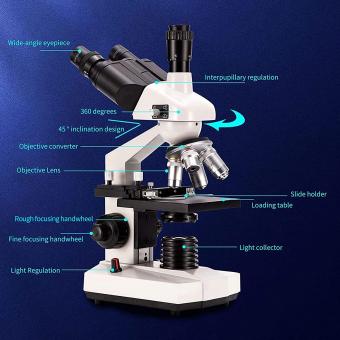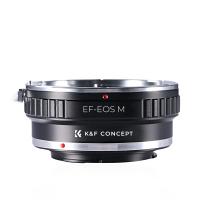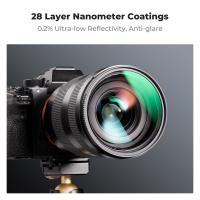How Many Times Can An Electron Microscope Magnify ?
An electron microscope can magnify up to 10 million times, which is much higher than the magnification of a light microscope. This high magnification is due to the use of electrons instead of light to create an image. The electrons are focused by magnetic lenses, which allow for a much higher resolution and greater detail in the image. Electron microscopes are commonly used in scientific research to study the structure of cells, tissues, and materials at the atomic and molecular level.
1、 Scanning Electron Microscope (SEM) magnification capabilities
The magnification capabilities of an electron microscope, specifically a Scanning Electron Microscope (SEM), are quite impressive. The SEM uses a beam of electrons to create high-resolution images of a sample, allowing for magnification up to millions of times.
To be more specific, the magnification of an SEM can range from around 20x to over 1,000,000x, depending on the instrument and the sample being observed. This level of magnification allows researchers to study the fine details of a sample, such as the structure of individual cells or the surface features of a material.
It is important to note that the magnification capabilities of an SEM are not limited by the lens, as in a traditional light microscope. Instead, the SEM uses electromagnetic lenses to focus the electron beam onto the sample, allowing for much higher magnification.
In recent years, advancements in SEM technology have allowed for even higher magnification capabilities. For example, the latest generation of SEMs can achieve resolutions down to a few nanometers, allowing for the observation of individual atoms and molecules.
Overall, the magnification capabilities of an SEM are truly remarkable and have revolutionized the field of microscopy. With continued advancements in technology, it is likely that even higher levels of magnification will be achievable in the future.

2、 Transmission Electron Microscope (TEM) magnification capabilities
The magnification capabilities of an electron microscope, specifically a Transmission Electron Microscope (TEM), are quite impressive. The magnification power of an electron microscope is determined by the wavelength of the electrons used to create the image. Electrons have a much shorter wavelength than light, which allows for much higher magnification capabilities.
In general, electron microscopes can magnify objects up to 10 million times their actual size. However, the exact magnification capabilities of a TEM can vary depending on the specific instrument and its settings. Some TEMs can magnify objects up to 50 million times their actual size.
It is important to note that while electron microscopes can achieve incredibly high magnification, they are limited in their ability to resolve fine details. This is due to the fact that electrons can interact with the sample being imaged, causing blurring and distortion. However, recent advancements in electron microscopy techniques, such as cryo-electron microscopy, have allowed for higher resolution imaging of biological samples.
In summary, the magnification capabilities of a Transmission Electron Microscope can vary, but in general, they can magnify objects up to 10-50 million times their actual size. While electron microscopes have limitations in their ability to resolve fine details, recent advancements in techniques have allowed for higher resolution imaging.

3、 Scanning Transmission Electron Microscope (STEM) magnification capabilities
An electron microscope is a powerful tool used to study the structure and properties of materials at the atomic and molecular level. It uses a beam of electrons instead of light to magnify the sample, allowing for much higher resolution and magnification than traditional optical microscopes.
The magnification capabilities of an electron microscope depend on the type of microscope being used. A transmission electron microscope (TEM) can magnify up to 10 million times, while a scanning electron microscope (SEM) can magnify up to 500,000 times. However, the magnification capabilities of a Scanning Transmission Electron Microscope (STEM) are even higher, with the ability to magnify up to 50 million times.
STEM is a type of electron microscope that combines the imaging capabilities of both TEM and SEM. It uses a focused beam of electrons to scan the sample, producing high-resolution images of the sample's internal structure. The magnification capabilities of STEM are due to its ability to focus the electron beam to a very small spot size, allowing for the imaging of individual atoms.
The latest advancements in STEM technology have allowed for even higher magnification capabilities. In 2018, researchers at the University of California, Los Angeles (UCLA) developed a STEM that can magnify up to 100 million times. This breakthrough was achieved by using a new type of electron detector that is more sensitive and can detect even weaker signals.
In conclusion, the magnification capabilities of an electron microscope depend on the type of microscope being used. STEM has the highest magnification capabilities, with the ability to magnify up to 50 million times, and the latest advancements have pushed this limit even further to 100 million times. These high magnification capabilities have revolutionized the field of materials science and have allowed for the study of materials at the atomic and molecular level.

4、 Environmental Scanning Electron Microscope (ESEM) magnification capabilities
An electron microscope is a powerful tool used to magnify objects that are too small to be seen by the naked eye. The magnification capabilities of an electron microscope are determined by the type of microscope being used. There are two main types of electron microscopes: transmission electron microscopes (TEM) and scanning electron microscopes (SEM).
The magnification capabilities of a TEM can range from 50x to 10,000,000x, depending on the type of sample being viewed and the resolution required. However, the magnification capabilities of a SEM are typically lower, ranging from 10x to 500,000x. This is because SEMs are designed to provide high-resolution images of the surface of a sample, rather than the internal structure.
One type of SEM, the Environmental Scanning Electron Microscope (ESEM), has the ability to image samples in a gaseous environment, allowing for the observation of samples that would otherwise be damaged or destroyed by the vacuum conditions required by traditional SEMs. The magnification capabilities of an ESEM are similar to those of a traditional SEM, ranging from 10x to 500,000x.
However, it is important to note that the magnification capabilities of an electron microscope are not the only factor that determines the quality of the image produced. Other factors, such as the resolution, contrast, and depth of field, also play a role in determining the quality of the image. Additionally, advances in technology have led to the development of electron microscopes with higher magnification capabilities and improved image quality.





























